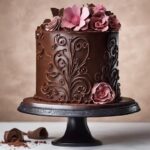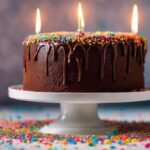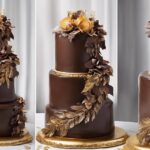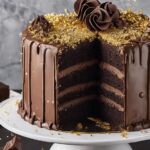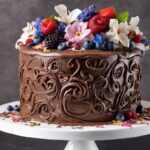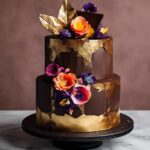Raw Food Ingredients
7 Chocolate Cake Decorating Ideas That Are Creative
Amp up your chocolate cake game with seven creative decorating ideas that will leave you inspired and craving more.
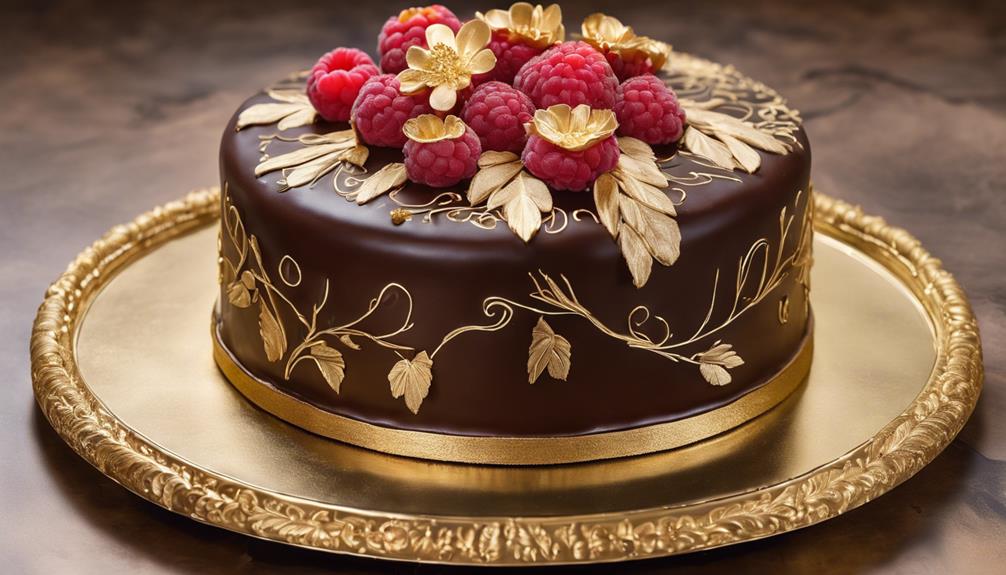
Let’s take your chocolate cake decorating skills to the next level with seven innovative and visually stunning ideas. Try creating an Elegant Floral Chocolate Cake adorned with edible flowers and greenery for a perfect touch. Experiment with an Ombre Chocolate Layer Cake by incorporating a gradient of chocolate shades for a bold effect. Explore a whimsical Chocolate Forest Cake featuring decorations inspired by the forest such as chocolate trees and mushrooms. Dive into a Marbled Chocolate Mirror Glaze Cake for a shiny finish with captivating marbled patterns. Think about trying a Geometric Chocolate Panel Cake for a contemporary look with detailed designs.
The Watercolor Chocolate Brushstroke Cake adds artistic elegance for special occasions. For a sophisticated look, think about Vintage Lace Chocolate Cake. These ideas will surely inspire your cake decorating creativity!
Key Takeaways
- Elegant Floral Chocolate Cake with edible flowers and intricate designs.
- Ombre Chocolate Layer Cake featuring gradient chocolate shades and decorations.
- Whimsical Chocolate Forest Cake with nature-inspired elements and whimsical decorations.
- Marbled Chocolate Mirror Glaze Cake with mesmerizing marbled patterns and glossy finish.
- Geometric Chocolate Panel Cake for a modern twist with intricate geometric designs.
Elegant Floral Chocolate Cake
To create an elegant floral chocolate cake, begin by selecting a harmonious combination of edible flowers and greenery for a visually striking presentation.
When decorating a delicious chocolate cake, incorporating edible flowers like roses, pansies, or violets can elevate its beauty. Use buttercream or fondant to craft intricate flower designs such as roses, peonies, or daisies for a realistic look that will surely impress.
Experimenting with different color palettes is key – pastel shades work wonderfully for a spring wedding, while vibrant colors are perfect for a birthday celebration. Adding greenery elements like leaves or vines can complement the floral decorations and enhance the overall aesthetic appeal of the cake.
Don't be afraid to mix and match a variety of flower types and sizes to create a dynamic and visually appealing composition on your chocolate masterpiece. Your guests will be amazed by the artistry and deliciousness of your floral chocolate cake creation.
Ombre Chocolate Layer Cake
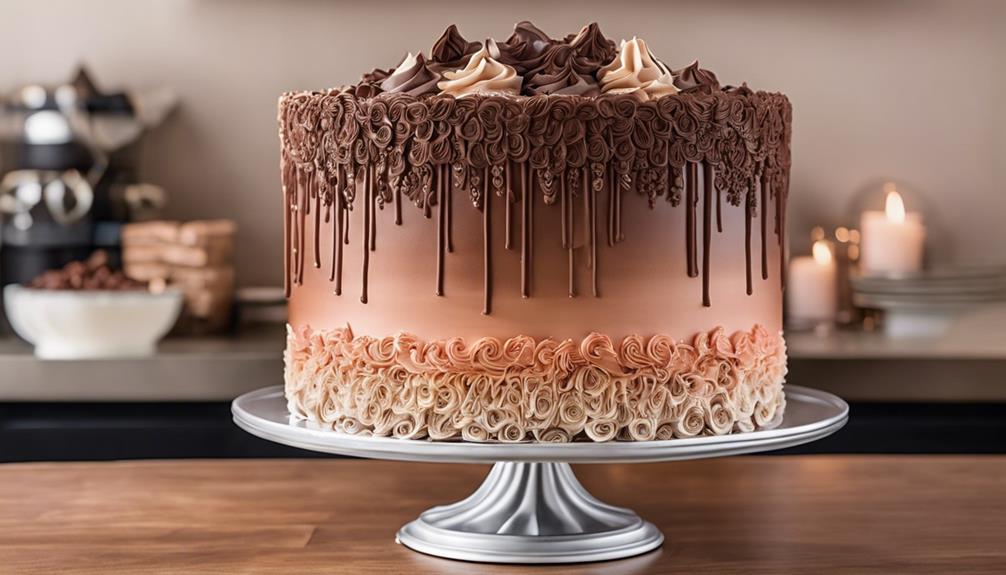
Using varying amounts of cocoa in each layer, I create a stunning gradient of chocolate shades in my Ombre Chocolate Layer Cake. This technique involves gradually darkening the chocolate hue from the bottom to the top, achieving a striking visual effect. The Ombre Chocolate Layer Cake isn't just a treat for the taste buds but also a feast for the eyes, making it a favorite among chocolate lovers. The shift from a light cocoa shade to a rich dark chocolate tone adds depth and dimension to the cake, elevating its appearance to a whole new level of sophistication.
To enhance the beauty of the Ombre Chocolate Layer Cake, you can decorate it with chocolate shavings, sprinkles, or even delicate edible flowers. These decorations complement the gradient effect and add a touch of elegance to the dessert. Whether you're celebrating a special occasion or simply craving the best chocolate cake, the Ombre Chocolate Layer Cake is sure to impress with its visually stunning presentation and delicious flavor.
Whimsical Chocolate Forest Cake
As I explore the whimsical world of chocolate cake decorating, the Whimsical Chocolate Forest Cake stands out as a delightful creation featuring layers of chocolate cake, rich buttercream, and enchanting forest-inspired decorations. This cake design is like stepping into a magical woodland setting, where each bite takes you deeper into a delicious forest adventure.
Here are some key elements that make this cake so special:
- Chocolate trees that add a whimsical touch.
- Edible moss for a realistic forest floor.
- Fondant woodland creatures that bring the forest to life.
- Green buttercream creating a lush forest floor ambiance.
The combination of chocolate rocks, edible flowers, and chocolate mushrooms adds a whimsical and enchanting feel to this cake. Perfect for nature lovers, fantasy-themed events, or outdoor-inspired celebrations, the Whimsical Chocolate Forest Cake is sure to captivate both the eyes and taste buds of anyone who encounters it.
Marbled Chocolate Mirror Glaze Cake
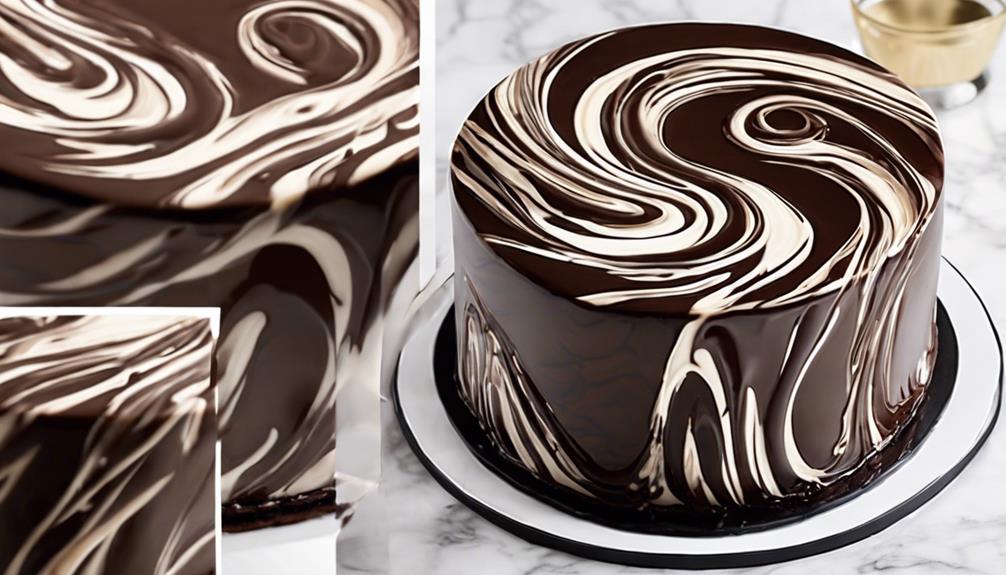
Exploring the art of cake decorating reveals the stunning allure of a Marbled Chocolate Mirror Glaze Cake. This dessert is a true masterpiece, featuring a glossy mirror glaze finish that mesmerizes the eyes and tantalizes the taste buds. To create this marvel, a mixture of chocolate, gelatin, sugar, and water is meticulously poured over a chilled cake, resulting in a smooth and reflective surface. The magic happens when different colors of mirror glaze are swirled together, producing a mesmerizing marbled effect that makes each cake unique.
Below is a table that encapsulates the essence of a Marbled Chocolate Mirror Glaze Cake:
| Feature | Description |
|---|---|
| Appearance | Glossy mirror glaze finish with intricate marbled patterns |
| Customization | Can be tailored with various colors and designs for a personalized touch |
| Technique | Requires precision and perfect timing to achieve the desired mirror effect |
Creating a Marbled Chocolate Mirror Glaze Cake is an art form that requires patience and attention to detail, but the final result is truly worth the effort.
Geometric Chocolate Panel Cake
Venturing into the domain of cake decoration, the Geometric Chocolate Panel Cake introduces a modern and sophisticated twist to traditional confectionery artistry. This technique involves creating intricate geometric designs using chocolate panels on the cake.
The panels are crafted by melting and shaping chocolate into various shapes like squares, triangles, or diamonds. These geometric panels can then be meticulously arranged in patterns or layers to achieve a visually stunning effect on the cake.
Precision and attention to detail are essential in ensuring the panels are placed accurately, resulting in a truly impressive dessert.
- Intricate geometric designs using chocolate panels
- Panels crafted by melting and shaping chocolate
- Meticulously arranged in patterns or layers
- Requires precision and attention to detail
Vintage Lace Chocolate Cake
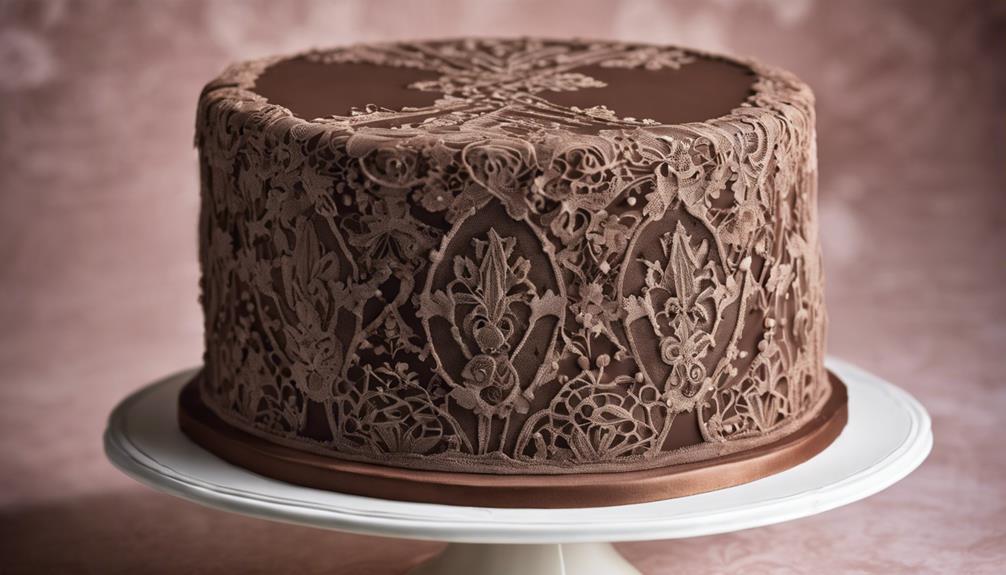
Let's explore the intricate lace patterns that adorn the Vintage Lace Chocolate Cake.
These delicate designs are crafted using melted white chocolate, adding a touch of elegance to the rich chocolate cake.
The contrast between the dark cake and the white lace creates a visually stunning and sophisticated appearance.
Lace Pattern Inspiration
Exploring the realm of vintage lace chocolate cakes reveals a world of intricate patterns that exude sophistication and allure. When seeking inspiration for lace patterns on chocolate cakes, consider the following:
- Vintage lace chocolate cakes showcase elaborate designs created from chocolate or fondant.
- These patterns often mimic traditional lace motifs seen on wedding gowns or tablecloths.
- Achieving a lace pattern on a chocolate cake requires precision and meticulous attention to detail.
- Various techniques like piping, stenciling, or using lace molds can help achieve the desired lace effect.
Experimenting with these techniques can enhance the elegance and charm of your chocolate cake, making it a breathtaking focal point for any occasion.
Chocolate Cake Design
Creating a Vintage Lace Chocolate Cake involves intricately piping melted chocolate onto the cake surface to achieve delicate lace-like motifs. This design requires patience and precision to create detailed patterns that exude elegance and sophistication.
The intricate lace patterns made with chocolate add a touch of timeless beauty to any special occasion, making it a popular choice for events like weddings and anniversaries. By carefully piping the melted chocolate in delicate motifs, you can achieve a stunning vintage lace effect that will impress your guests.
The process of creating a Vintage Lace Chocolate Cake may take time, but the end result is a visually enchanting masterpiece that not only tastes delicious but also showcases your attention to detail and creativity.
Decorating Techniques Used
Utilizing intricate piping techniques with melted chocolate, the Vintage Lace Chocolate Cake design elevates the cake's aesthetic with delicate lace patterns.
- Delicate lace patterns are created using piped chocolate.
- Precision and patience are essential for achieving intricate designs.
- Different shades of chocolate can enhance the vintage lace effect.
- Practice with various lace patterns helps master the art of Vintage Lace Chocolate Cake decorating.
Decorating a cake with Vintage Lace Chocolate design requires attention to detail and a steady hand. By mastering the piping techniques and experimenting with different chocolate shades, bakers can achieve a sophisticated and elegant look for their cakes. The intricate lace patterns add a touch of charm and beauty, making the cake a stunning centerpiece for any special occasion.
Watercolor Chocolate Brushstroke Cake
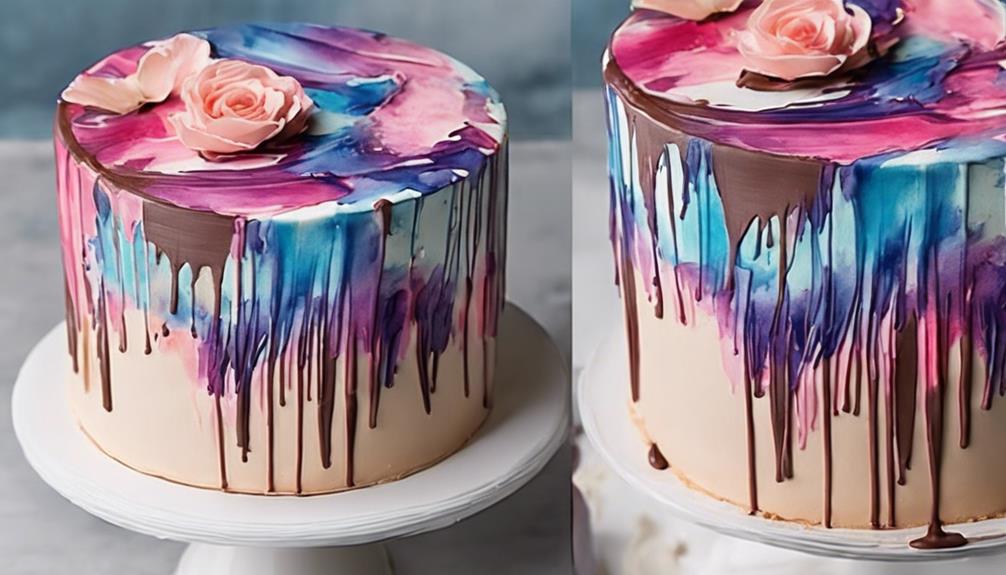
Watercolor Chocolate Brushstroke Cakes bring a touch of artistic elegance to any special occasion with their delicate and customizable designs using colored chocolate or cocoa butter. This trendy cake decoration technique mimics the look of watercolor paintings, creating a stunning visual effect.
By delicately applying colored chocolate or cocoa butter in artistic brushstrokes on the cake's surface, a beautiful watercolor effect is achieved. The ability to blend these brushstrokes together allows for endless possibilities in design, making each cake a unique work of art.
These cakes are particularly popular for weddings, birthdays, and other special events due to their elegant and sophisticated appearance. The versatility of this decorating technique allows for creativity and customization, enabling decorators to match various themes and preferences.
With Watercolor Chocolate Brushstroke Cakes, you can add a personalized and artistic touch to your celebrations, making them truly unforgettable.
Frequently Asked Questions
What Can I Decorate a Chocolate Cake With?
I can decorate a chocolate cake with fresh berries, edible flowers, chocolate shavings, sprinkles, and fondant decorations. These options add color, flavor, and style to the cake, making it visually appealing and delicious for any occasion.
How Do You Make a Cake Look Amazing?
To make a cake look amazing, I incorporate textures like chocolate shavings, use vibrant colors with berries, experiment with unique designs like drip cakes, and add themed decorations for a fun touch. Fruit and chocolate combos also create eye-catching designs.
What Compliments Chocolate Cake?
I love how fresh berries like raspberries and blueberries bring a burst of fruity flavor to chocolate cake. Nuts add a crunchy texture, while whipped cream or vanilla ice cream balance the richness. Caramel drizzle and coffee elements enhance the sweetness and depth.
What Are Some Good Cake Themes?
When it comes to good cake themes, I love the versatility of confetti cakes for birthdays, the whimsy of unicorn designs for kids, the elegance of winter wonderland creations, the fun of Halloween motifs, and the tradition of Yule Log cakes for Christmas.
Can I Use the Ultimate Guide for Chocolate Cake Decorations to Implement the 7 Creative Decorating Ideas?
Yes, you can use the ultimate chocolate cake decorations guide to implement the 7 creative decorating ideas. This guide provides step-by-step instructions and various techniques to elevate the presentation of your chocolate cake. With these creative ideas, you can take your cake decorating skills to the next level.
Conclusion
Now that you have learned about these creative chocolate cake decorating ideas, it's time to put your skills to the test. Which design will you try first?
Whether it's the elegant floral cake or the whimsical forest cake, the possibilities are endless.
Get creative in the kitchen and impress your friends and family with your beautiful and delicious chocolate creations.
Have fun experimenting and enjoy the sweet rewards of your hard work!
Rachael, the Editor in Chief of RachaelsRawFood.com, is an inspiring and passionate individual who has dedicated her life to promoting the benefits of a raw food lifestyle. Known for her vibrant and energetic personality, Rachael has built a strong online presence that has transformed her personal journey into a thriving community of raw food enthusiasts.
Raw Food Ingredients
How Much Caffeine in Cocoa?
Not all cocoa products are created equal when it comes to caffeine content – discover which one might surprise you!

When evaluating the caffeine levels in cocoa, it’s important to recognize that dark chocolate contains around 43 mg of caffeine per 100 grams due to its high cocoa solid content. Dark chocolate has a higher caffeine content compared to milk or white chocolate. This means that consuming dark chocolate in moderation can assist in managing your caffeine intake. On the other hand, milk chocolate has around 20 mg of caffeine per 100 grams while white chocolate is caffeine-free. Cocoa powder, commonly used in baking and beverages, contains a substantial 230 mg of caffeine per 100 grams. Being aware of these distinctions in chocolates can help you make informed decisions about your caffeine consumption.
Key Takeaways
- Caffeine content in cocoa varies based on cocoa solid concentrations.
- Unsweetened cocoa powder can contain around 230 mg of caffeine per 100 grams.
- Roasting cocoa solids influences the final caffeine content in cocoa products.
- Dark chocolate, with high cocoa solid content, has more caffeine than milk chocolate.
- Moderate consumption of cocoa products helps manage caffeine intake.
Caffeine Content in Dark Chocolate
Dark chocolate boasts a caffeine content of approximately 43 mg per 100 grams, mainly deriving from its higher cocoa solid composition. When we indulge in this decadent treat, we aren't only savoring its rich cocoa flavor but also a subtle caffeine kick. Compared to milk or white chocolate, dark chocolate contains a higher amount of caffeine.
Please bear in mind that moderate consumption of dark chocolate can assist individuals in managing their caffeine intake effectively. The caffeine levels in dark chocolate are about one-fourth of what you'd find in a standard cup of coffee. So, if you're looking for a milder caffeine boost, a piece of dark chocolate might just do the trick without the jitters that sometimes accompany a strong cup of coffee.
Enjoy your dark chocolate in moderation, savoring both its taste and the gentle pick-me-up it provides.
Caffeine Levels in Milk Chocolate

Milk chocolate, known for its creamy texture and sweet flavor, contains a modest caffeine content of approximately 5.6 mg per ounce, as indicated by USDA data. Unlike dark chocolate, milk chocolate has a lighter color due to lower cocoa content, resulting in reduced caffeine levels.
The delightful creamy taste in milk chocolate comes from a harmonious blend of cocoa and milk powder. While dark chocolate boasts higher caffeine content, milk chocolate remains a popular choice for those seeking a sweet treat with minimal caffeine intake.
Caffeine Presence in White Chocolate
With its unique composition excluding cocoa solids, white chocolate stands out as a caffeine-free alternative to its darker counterparts. White chocolate is crafted from a blend of cocoa butter, milk powder, sugar, and vanilla, making it a delectable treat without the stimulating effects of caffeine. For individuals sensitive to caffeine, white chocolate offers a creamy texture and indulgent flavor without the worry of unwanted side effects. This makes it a popular choice for desserts among those looking to steer clear of caffeine in their sweet treats.
Compared to dark chocolate, which contains cocoa solids and hence caffeine, white chocolate provides a caffeine-free option for those seeking a more mellow indulgence. So, if you're in the mood for a luscious and smooth chocolate experience without the buzz of caffeine, white chocolate is the perfect choice for your next dessert delight.
Impact of Cocoa Solids on Caffeine

In determining the caffeine levels in cocoa products, the percentage of cocoa solids plays a significant role. Here are some key points about the impact of cocoa solids on caffeine content:
- Caffeine Derivation: The caffeine content in cocoa primarily comes from cocoa solids, making it an important factor in determining the overall caffeine levels in cocoa-based products.
- Dark Chocolate: Dark chocolate, known for its higher cocoa solid content, tends to contain more caffeine compared to milk or white chocolate varieties due to this higher concentration.
- Unsweetened Cocoa Powder: A 100g serving of unsweetened cocoa powder can contain around 230mg of caffeine, reflecting the impact of the high cocoa solid content in this form.
- Health Benefits: The roasting process of cocoa solids not only affects the flavor profile but also influences the caffeine content, contributing to the potential health benefits associated with consuming cocoa products like hot cocoa.
Comparing Caffeine in Different Chocolates
Comparing the caffeine content in different chocolates reveals varying levels based on their cocoa solid concentrations. Dark chocolate contains about 43 mg of caffeine per 100 grams, making it a stronger caffeinated option compared to milk chocolate, which only has around 20 mg per 100 grams.
Surprisingly, white chocolate, derived from cocoa butter, doesn't contain any caffeine at all. For those seeking a more potent caffeine kick, cocoa powder is the way to go, boasting a high concentration of 230 mg per 100 grams.
The amount of caffeine in chocolate products is closely linked to the cocoa solid content, with dark chocolate containing the highest levels. So, the next time you're craving a chocolate treat but also need a little energy boost, opt for dark chocolate to get the most caffeine per bite.
Frequently Asked Questions
Is There More Caffeine in Cocoa Than Coffee?
There's more caffeine in cocoa than in coffee. Cocoa powder packs 230 mg per 100 grams, surpassing most coffee varieties. Dark chocolate has even more caffeine due to higher cocoa content. It's a rich, unique energy source.
Is There a Lot of Caffeine in Hot Cocoa?
There isn't a lot of caffeine in hot cocoa. It depends on the brand and recipe. Starbucks hot chocolate has around 25 mg per serving, while basic mixes have about 5 mg. The amount of cocoa powder used influences the caffeine content.
Is There Caffeine in Hershey's Cocoa?
Absolutely, Hershey's Cocoa does contain caffeine, but it's not overwhelming. It adds a delightful hint of energy in each spoonful. Perfect for baking or a cozy cup of hot chocolate. Just the right amount!
Is Cocoa a Stimulant Like Caffeine?
Cocoa stimulates like caffeine due to its theobromine content. Decaf versions offer a solution for caffeine-sensitive folks. Options include regular cocoa with caffeine, Dutch-processed cocoa with less, and decaf cocoa with reduced caffeine while keeping healthful compounds.
What are the potential health effects of consuming high levels of caffeine in cocoa?
Unveiling cocoa caffeine levels can lead to potential health effects of excessive consumption. High levels of caffeine in cocoa may contribute to insomnia, nervousness, and fast heartbeat. It can also cause gastrointestinal discomfort and exacerbate anxiety disorders. Moderation in consuming caffeinated cocoa products is recommended for overall health.
Conclusion
To sum up, the caffeine content in cocoa varies depending on the type of chocolate. Dark chocolate typically has the highest caffeine levels, followed by milk chocolate and white chocolate. The amount of cocoa solids in the chocolate also affects the caffeine content.
Remember, just like different chocolates have different levels of caffeine, we all have unique strengths and abilities. Embrace your individuality and always aim for balance in everything you do.
Rachael, the Editor in Chief of RachaelsRawFood.com, is an inspiring and passionate individual who has dedicated her life to promoting the benefits of a raw food lifestyle. Known for her vibrant and energetic personality, Rachael has built a strong online presence that has transformed her personal journey into a thriving community of raw food enthusiasts.
Raw Food Ingredients
5 Key Differences: Caffeine Content in Cocoa Vs Coffee
Open the door to understanding the contrasting caffeine levels in cocoa and coffee, revealing surprising insights that will reshape your beverage choices.

When comparing the caffeine levels in cocoa and coffee, it is important to understand that cocoa generally has lower caffeine content than coffee. Dark chocolate contains approximately 12 milligrams of caffeine per ounce, while hot cocoa typically ranges from 5 to 10 milligrams per ounce. In contrast, brewed coffee can have significantly higher levels, varying from 95 to 165 milligrams per 8-ounce cup.
Cocoa is considered a milder option for individuals aiming to limit their caffeine intake, with theobromine providing a gradual energy increase. Meanwhile, coffee's caffeine content offers immediate alertness, and understanding these distinctions can help you select based on your preferred effects.
Key Takeaways
- Cocoa contains lower caffeine levels but compensates with theobromine for a gradual energy increase.
- Coffee has higher caffeine content, offering an immediate alertness boost and potentially higher metabolic rate.
- Theobromine in cocoa promotes relaxation, while caffeine in coffee provides intense alertness and mood fluctuations.
- Hot chocolate is a good option for reducing caffeine intake while still benefiting from theobromine effects.
- Understanding caffeine variances helps make informed choices for desired energy levels and mood effects.
Caffeine Levels in Cocoa Vs Coffee
When comparing caffeine levels in cocoa versus coffee, it's evident that cocoa generally contains lower amounts per serving. Dark chocolate, made from cacao beans, contains around 12 milligrams of caffeine per ounce, while a 1-ounce serving of hot cocoa mix typically has 5-10 milligrams. Even a 16-ounce serving of Starbucks hot chocolate only contains about 25 milligrams of caffeine.
On the other hand, coffee, when brewed, can range from 95 to 165 milligrams of caffeine per 8-ounce cup, depending on the type and brewing method. This significant difference in caffeine content between cocoa and coffee makes cocoa a milder option for those looking to limit their caffeine intake.
Impact on Alertness and Energy

Typically, the immediate alertness and energy boost from caffeine in coffee can last for hours. This surge in alertness is due to caffeine's stimulating effect on the central nervous system. On the other hand, cocoa contains theobromine, which provides a more gradual increase in energy levels. Unlike caffeine, theobromine doesn't cause sudden spikes and crashes, offering a smoother energy curve.
Coffee's caffeine content can temporarily boost the metabolic rate, potentially supporting weight management efforts. This increased metabolic rate can aid in burning calories and may contribute to weight loss when combined with a balanced diet and regular exercise. Additionally, theobromine in cocoa contributes to the thermogenic effect, leading to mild calorie burning in the body.
Both caffeine and theobromine can influence mood. Caffeine tends to provide a more intense and quick-acting mood elevation, while theobromine promotes feelings of relaxation and contentment. Understanding the differences in alertness, energy, metabolic effects, and mood enhancements between cocoa and coffee can help individuals make informed choices based on their preferences and wellness goals.
Metabolic Variances and Effects
Regarding metabolic variances and effects, the varying caffeine levels between cocoa and coffee play a significant role. When comparing the metabolic impact of caffeine in cocoa and coffee, it is crucial to note that cocoa contains lower levels of caffeine but compensates with theobromine, which aids in the thermogenic effect, promoting calorie burning and metabolic activity. On the other hand, coffee, especially brewed varieties, contains higher levels of caffeine, potentially providing a temporary boost to the metabolic rate, which could assist in weight management. While caffeine in coffee offers a quick energy surge, theobromine in cocoa leads to a more gradual rise in energy levels, avoiding sudden spikes and crashes. To summarize the metabolic differences, I've created a table below:
| Aspect | Cocoa | Coffee |
|---|---|---|
| Caffeine Content | Lower levels | Higher levels |
| Additional Component | Theobromine | Caffeine |
| Metabolic Impact | Thermogenic effect | Temporary metabolic rate boost |
| Energy Levels | Gradual rise | Quick surge |
| Weight Management | Aids in calorie burning | Potential assistance |
Mood Enhancement Disparities

In comparing the mood enhancement effects of theobromine in cocoa and caffeine in coffee, notable disparities emerge in their impact on mental well-being.
The theobromine found in cocoa promotes relaxation and contentment, offering a gradual rise in energy levels that leads to a gentle and long-lasting mood enhancement experience.
On the other hand, caffeine delivers an intense and fast-acting boost in alertness, providing immediate energy levels that can lead to abrupt spikes and crashes.
While both theobromine and caffeine uplift mood, theobromine's effects are characterized by a steady and gradual increase in energy levels, creating a sense of calm and contentment.
In contrast, caffeine's impact is more intense and temporary, resulting in rapid alertness but also the potential for fluctuations in mood. Understanding these differences can help individuals choose between cocoa and coffee based on their desired mood enhancement effects.
Health Implications and Considerations
Health implications and considerations surrounding caffeine consumption warrant close attention due to its potential impact on various aspects of well-being. When comparing a cup of coffee to hot chocolate, it's vital to note the amount of caffeine present.
While coffee contains much caffeine, hot chocolate has less caffeine but isn't entirely devoid of it. The main active ingredients in hot chocolate are theobromine and caffeine, where theobromine is a relative of caffeine and also has stimulant effects, although milder. If you're looking to reduce your caffeine intake, opting for hot chocolate over a cup of coffee can be a good choice.
Being mindful of the caffeine content in chocolate products is important, especially if you're sensitive to caffeine or belong to vulnerable populations like children or pregnant women. Understanding the caffeine levels in different beverages allows you to make informed decisions about your consumption for better overall health.
Frequently Asked Questions
Is There Caffeine in Coffee Vs Cacao Powder?
Yes, there is caffeine in coffee, with around 140 milligrams in a 12-ounce cup. On the other hand, cacao powder contains only about 12 milligrams per tablespoon, making it a great caffeine-free alternative for those seeking a milder boost.
What Is the Difference Between Cocoa and Coffee?
When comparing cocoa and coffee, cocoa offers a rich, chocolatey flavor and is packed with antioxidants and minerals. Coffee, on the other hand, provides a robust, bitter taste and a jolt of caffeine for that morning pick-me-up.
Why Is Cocoa Better Than Coffee?
I believe cocoa is superior to coffee because it offers a gentler energy boost, promotes relaxation and contentment, and provides sustained vitality without sudden crashes. Plus, dark chocolate's theobromine supports cellular health and tastes delicious.
How Much Caffeine Is in Cocoa Powder Vs Decaf Coffee?
In cocoa powder vs decaf coffee, cocoa has 12-26mg of caffeine per tbsp, while decaf coffee holds 2-5mg per 8-ounce cup. The choice hinges on desired caffeine levels and flavor. I prefer cocoa's lower caffeine content.
How does the caffeine content in hot chocolate compare to coffee?
Hot chocolate caffeine content is significantly lower than that of coffee. While an 8-ounce cup of hot chocolate contains about 5-10 milligrams of caffeine, the same size of coffee can have anywhere from 95-200 milligrams. It’s a notable difference for those looking to limit their caffeine intake.
Conclusion
To sum up, while cocoa and coffee both contain caffeine, the levels vary significantly. Cocoa generally has lower caffeine content compared to coffee, impacting alertness, energy levels, and mood enhancement differently.
It's crucial to keep these differences in mind when choosing between the two beverages for your daily consumption. Remember, moderation is key to maintaining a healthy balance in your caffeine intake.
So, whether you prefer a cup of cocoa or a mug of coffee, enjoy it in moderation for the best benefits!
Rachael, the Editor in Chief of RachaelsRawFood.com, is an inspiring and passionate individual who has dedicated her life to promoting the benefits of a raw food lifestyle. Known for her vibrant and energetic personality, Rachael has built a strong online presence that has transformed her personal journey into a thriving community of raw food enthusiasts.
Raw Food Ingredients
A Guide to Becoming a Good King
Kingship demands wisdom, fairness, integrity, courage, and humility – essential traits for a successful reign and prosperous kingdom." Keep reading to uncover the secrets of becoming a good king.

In order to be a good king, one must embody wisdom, fairness, integrity, courage, and humility to lead the kingdom with honor. Wisdom is essential for making important decisions, fairness ensures just treatment for all, integrity builds trust and respect, courage is crucial for facing challenges, and humility reminds us of our humanity. Historical kings such as Solomon, Arthur, David, Charlemagne, and Ramses II serve as role models for these leadership traits.
As a king, embracing challenges, understanding the world, seeking personal growth, and learning from the past are essential responsibilities. Developing leadership skills, making wise decisions, and prioritizing the well-being of the people are key to effective kingship. Every step on the path to becoming a good king is critical for a successful reign and prosperous kingdom.
Key Takeaways
- Embrace wisdom for informed decisions.
- Practice fairness for just treatment.
- Uphold integrity to earn trust.
- Show courage in facing challenges.
- Maintain humility for empathy and respect.
Qualities of a Good King
Being a good king requires embodying qualities such as wisdom, fairness, integrity, courage, humility, and compassion in decision-making and leadership. Power comes with responsibility, and as a king, it's essential to wield this power wisely. Wisdom is vital in making sound judgments that benefit the kingdom as a whole. Fairness guarantees that all subjects are treated justly and equitably, fostering a harmonious society. Integrity is the foundation of trust and respect, key elements in effective leadership.
Courage is necessary to face challenges and make difficult decisions, even when met with opposition. Humility reminds a king of his humanity and the importance of humility in interactions with all subjects. Compassion demonstrates a king's care and empathy towards his people, fostering a sense of unity and loyalty. Effective communication is crucial for conveying decisions, listening to concerns, and inspiring confidence in leadership.
Historical Kings as Role Models

King Solomon, renowned for his wisdom and leadership, stands as an exemplar among historical kings who serve as role models for future leaders. Looking at figures like King Arthur, known for his justice and valor in medieval legends, and King David, celebrated for his faith and courage in battle, we find lessons that transcend time. Charlemagne's legacy of military conquests and cultural revival, alongside Ramses II's grand building projects and military campaigns, offer diverse insights into effective kingship. Below is a table summarizing key attributes of these historical kings:
| King | Attributes |
|---|---|
| King Solomon | Wisdom, leadership |
| King Arthur | Justice, valor |
| King David | Faith, courage |
| Charlemagne | Military prowess, culture revival |
| Ramses II | Building projects, military campaigns |
Studying these historical figures can provide valuable lessons on the multifaceted qualities that make a great ruler.
Responsibilities of Kingship
Embracing challenges and living authentically are central to fulfilling the responsibilities inherent in kingship. As men aspiring to be good kings, it's essential for us to understand that the world requires leaders who are kind, humble, and committed to personal growth.
The journey to becoming a good king involves more than just wielding power and responsibility—it entails sacrificing comfort for growth and transformation. Seeking the ancient path of masculinity, as exemplified by figures like Morgan, teaches us the importance of humility, vulnerability, and character development.
In fulfilling the responsibilities of kingship, we're entrusted with power not for our own gain, but for the betterment of the world around us. Just as seeds need Good Soil to flourish, we must nurture our own growth to lead effectively.
Leadership Skills for Kings

Developing essential leadership skills is crucial for aspiring kings seeking to fulfill their responsibilities with humility, vulnerability, and a focus on character development. As you study the world around us, the power and responsibility of what kingship entails become clearer. Here are some key points to think about on your path to becoming a king:
- Embrace challenges and live authentically.
- Seek ancient paths of masculinity for guidance.
- Reflect on your identity, purpose, and ability to be entrusted with power for good.
- Sacrifice comfort for growth, transformation, and participation in universal creativity.
The journey of becoming a king isn't just about gaining authority but about understanding the remarkable fellowship of like-hearted individuals who share similar goals. Engage in group discussion questions, consider between-session personal study, and explore the depths of your masculine soul. This is the path to restoring what it means to be a true king.
Importance of Wise Decision-Making
Steering through the intricacies of leadership, especially in the domain of kingship, requires a sharp focus on the art of prudent decision-making. Wise decision-making is like the compass guiding the ship of leadership towards success.
Good kings understand that their choices impact not just themselves but also the lives of those they rule over. They prioritize the well-being of their people over personal gains, embodying the essence of true leadership.
Seeking counsel from trusted advisors and reflecting on core values are essential practices in the domain of wise decision-making. By embracing humility and self-awareness, kings can navigate the complex web of choices with clarity and integrity.
Just like a six-session video Bible study can guide individuals in restoring the heart, wise decision-making is essential for becoming the kind of leaders our world needs. Let's start on this journey of radical reconstruction, where every decision is a step towards being counted among the good kings of history.
Frequently Asked Questions
What Is the Becoming a King Guide?
The Becoming a King guide is a transformative resource created by Morgan Snyder to help men grow into responsible kings. It offers practical tools and profound insights to aid personal development and transformation.
What Are the Qualities of a Good King?
Being a good king means embodying humility, wisdom, and integrity. Prioritizing the well-being of my people, making decisions for the greater good, and showing courage, justice, and compassion in all actions. Seeking counsel and valuing diverse perspectives is essential.
What Makes a True King?
Beneath the crown lies a heart that beats with humility and a spirit that soars with honor. True kings are forged in the fires of challenge, embracing authenticity and growth to inspire others.
What Makes a Real King?
Being a true king means embodying humility, courage, and empathy. It's about serving others and leading with integrity. I endeavor to cultivate these qualities daily, embracing challenges and seeking growth in all aspects of my life.
How Can Sacred Cacao be Incorporated Into Kingship Rituals?
In kingship rituals, the sacred cacao ritual holds great significance. The ceremonial drinking of cacao symbolizes the divine connection between the ruler and the spiritual realm. It is believed to impart wisdom and strength, making it a crucial element in the coronation and leadership rites of many cultures.
Conclusion
To sum up, becoming a good king requires a combination of qualities, skills, and responsibilities. Remember, 'With great power comes great responsibility.'
By studying historical kings as role models, practicing leadership skills, and making wise decisions, one can aspire to be a just and effective ruler.
It's a challenging path, but with dedication and perseverance, anyone can endeavor to be a worthy leader for their kingdom.
Rachael, the Editor in Chief of RachaelsRawFood.com, is an inspiring and passionate individual who has dedicated her life to promoting the benefits of a raw food lifestyle. Known for her vibrant and energetic personality, Rachael has built a strong online presence that has transformed her personal journey into a thriving community of raw food enthusiasts.
-

 Raw Food Ingredients2 months ago
Raw Food Ingredients2 months agoHow To Make Hot Chocolate With Raw Cacao Powder
-

 Raw Food Ingredients2 months ago
Raw Food Ingredients2 months agoHow To Make Chocolate From Raw Cacao
-

 What is Raw Food?2 weeks ago
What is Raw Food?2 weeks agoHow To Remove Raw Mustard Oil Smell From Cooked Food
-

 Raw Food Ingredients4 weeks ago
Raw Food Ingredients4 weeks agoRaw Cacao Powder How Much For 8 Oz Hot Chocolate Recipe
-

 Raw Food Ingredients4 weeks ago
Raw Food Ingredients4 weeks agoThe Truth Behind the Cacao Caffeine Myth
-

 Raw Food Ingredients2 months ago
Raw Food Ingredients2 months agoWhen Fasting Can I Drink Coffee With Raw Cacao Powder
-

 What is Raw Food?2 weeks ago
What is Raw Food?2 weeks agoHow To Store Raw And Cooked Food Separately
-

 Raw Food Ingredients2 months ago
Raw Food Ingredients2 months agoHow To Use Raw Cacao Beans




